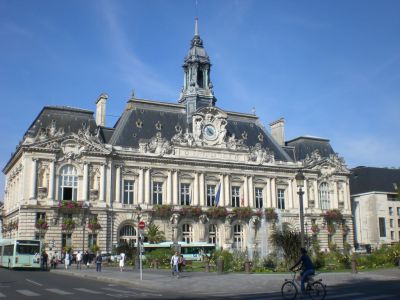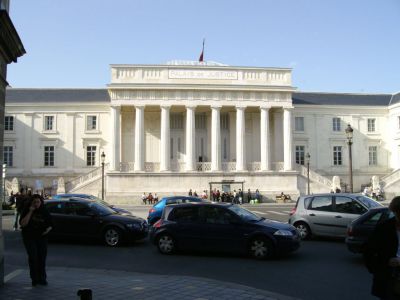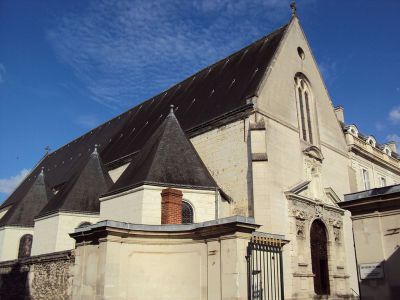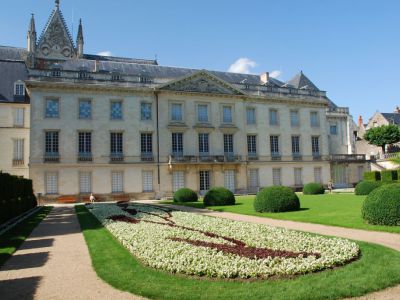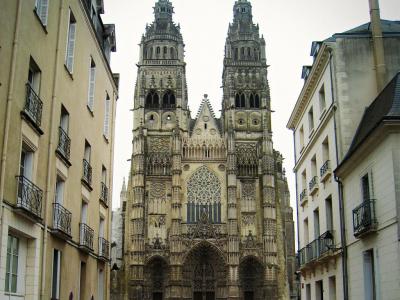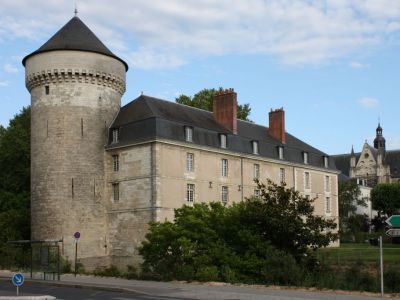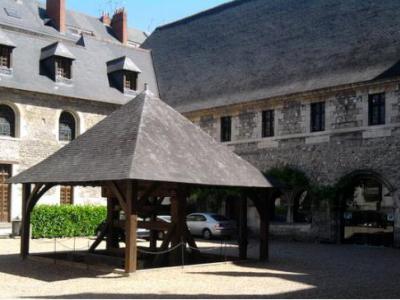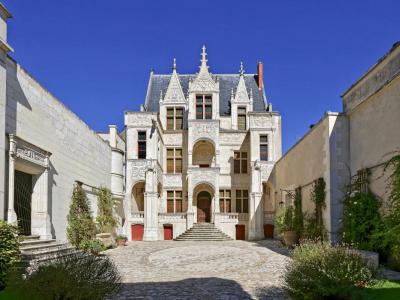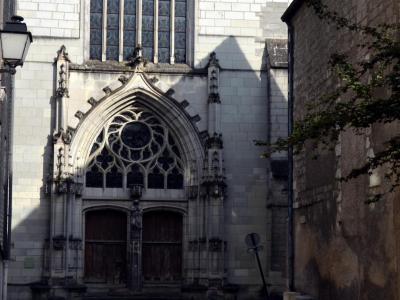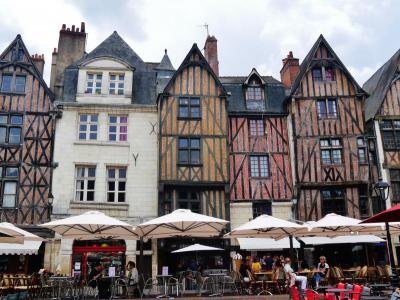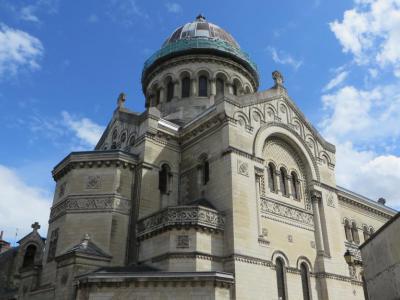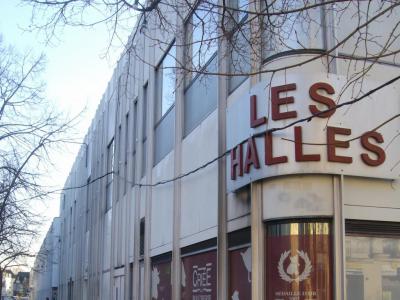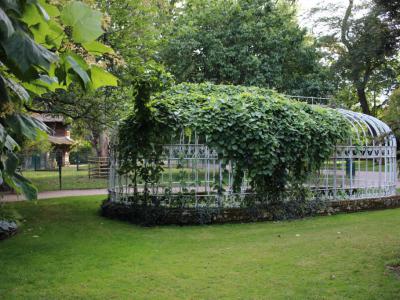Custom Walk in Tours, France by anarob65_82296 created on 2025-06-09
Guide Location: France » Tours
Guide Type: Custom Walk
# of Sights: 14
Tour Duration: 3 Hour(s)
Travel Distance: 4.6 Km or 2.9 Miles
Share Key: F44VS
Guide Type: Custom Walk
# of Sights: 14
Tour Duration: 3 Hour(s)
Travel Distance: 4.6 Km or 2.9 Miles
Share Key: F44VS
How It Works
Please retrieve this walk in the GPSmyCity app. Once done, the app will guide you from one tour stop to the next as if you had a personal tour guide. If you created the walk on this website or come to the page via a link, please follow the instructions below to retrieve the walk in the app.
Retrieve This Walk in App
Step 1. Download the app "GPSmyCity: Walks in 1K+ Cities" on Apple App Store or Google Play Store.
Step 2. In the GPSmyCity app, download(or launch) the guide "Tours Map and Walking Tours".
Step 3. Tap the menu button located at upper right corner of the "Walks" screen and select "Retrieve custom walk". Enter the share key: F44VS
1) Hotel de Ville (City Hall) (must see)
Joan of Arc is remembered and celebrated in the City Hall of Tours. A triptych of her life by Jean-Paul Laurens decorates the hall. It is appropriate. Wars are recalled in a staircase. The aspirations of the revolution are not overlooked.
On the ground floor there is a stone peristyle serving as an exhibition space. The building is rather huge compared to the Place Jean-Jaeres or the Palace of Justice. More than any other civic building, it is meant to declare the virtues and authority of the Republic. The hall has a distinct Parisian ambience.
Various artists have contributed to this Hall on the Loire. There are four Atlantean sculptures by Francois Sicard on the facade. There is the clock, flanked by two caryatids, "Day and Night" by Emile Joseph Nestor Carlier. The rivers Loire and Cher are represented by two lengthy figures created by Jean-Antoine Injalbert.
The east and west wings of the Hall are decorated with works of art. "Courage" and "Strength" of Jean-Baptiste Hugues in the west wing. In the east wing we have "Education" and Vigilance" by Alphonse Cordonnier. The roof served as a model for the Hotel de Ville in Montreal Canada in 1922 when its roof was destroyed by fire.
The hall was built in 1904 by Victor Laloux. Inside the Hall as one enters, there is a golden square-shaped dome with the letters "RF", "Republique Francais." Saint Joan would approve.
On the ground floor there is a stone peristyle serving as an exhibition space. The building is rather huge compared to the Place Jean-Jaeres or the Palace of Justice. More than any other civic building, it is meant to declare the virtues and authority of the Republic. The hall has a distinct Parisian ambience.
Various artists have contributed to this Hall on the Loire. There are four Atlantean sculptures by Francois Sicard on the facade. There is the clock, flanked by two caryatids, "Day and Night" by Emile Joseph Nestor Carlier. The rivers Loire and Cher are represented by two lengthy figures created by Jean-Antoine Injalbert.
The east and west wings of the Hall are decorated with works of art. "Courage" and "Strength" of Jean-Baptiste Hugues in the west wing. In the east wing we have "Education" and Vigilance" by Alphonse Cordonnier. The roof served as a model for the Hotel de Ville in Montreal Canada in 1922 when its roof was destroyed by fire.
The hall was built in 1904 by Victor Laloux. Inside the Hall as one enters, there is a golden square-shaped dome with the letters "RF", "Republique Francais." Saint Joan would approve.
2) Palais de Justice (Courthouse)
The Tours Courthouse (Palais de Justice de Tours), constructed between 1840 and 1843, is a prime example of Neoclassical architecture, designed by Jean-Charles Jacquemin-Belisle and his son Jean Jacquemin. Situated prominently on Place Jean Jaurès, next to Tours City Hall and symmetrically aligned with National Street (Rue Nationale), this courthouse stands out with its white stone construction and an imposing colonnade that faces the bustling place.
The design features tall, striking columns and meticulous engravings that decorate the columns, barriers, and high reliefs, contributing to the building's majestic appearance. Notably, the courthouse dazzles visitors, especially on sunny days when the light strongly reflects off the white stones, enhancing its splendor.
The Courthouse also commands a significant geographical presence as it overlooks Boulevard Béranger and includes an inner courtyard behind its façade. It houses important judicial functions such as the judicial court and the juvenile court. The judicial court, now housed here, was formed from the merger of the Court of First Instance (TGI) and the Court of First Instance (TI).
Historically, the Tours Courthouse has been the venue for high-profile cases, underscoring its importance in the French judicial system. Its location next to the town hall on Place Jean Jaurès further adds to the prestige of the area, making it not only a center of judicial activity but also a landmark of architectural and cultural significance.
The design features tall, striking columns and meticulous engravings that decorate the columns, barriers, and high reliefs, contributing to the building's majestic appearance. Notably, the courthouse dazzles visitors, especially on sunny days when the light strongly reflects off the white stones, enhancing its splendor.
The Courthouse also commands a significant geographical presence as it overlooks Boulevard Béranger and includes an inner courtyard behind its façade. It houses important judicial functions such as the judicial court and the juvenile court. The judicial court, now housed here, was formed from the merger of the Court of First Instance (TGI) and the Court of First Instance (TI).
Historically, the Tours Courthouse has been the venue for high-profile cases, underscoring its importance in the French judicial system. Its location next to the town hall on Place Jean Jaurès further adds to the prestige of the area, making it not only a center of judicial activity but also a landmark of architectural and cultural significance.
3) Rue Nationale (National Street) (must see)
National Street (Rue Nationale) in Tours is one of the city's oldest and busiest shopping streets, reflecting centuries of history, architecture, and urban planning. Spanning 700 meters through the city center, this north-south street connects the Place Anatole France and Pont Wilson to Avenue de Grammont, forming part of a straight seven-kilometer road that includes Avenue de la Tranchée and Avenue de Grammont.
Originally known as Royal Street (Rue Royale), the street was restructured in 1777 based on designs by Jean Cabet de Limeray. This marked a pivotal shift in the city's urban layout, changing from an east-west to a north-south axis, centered around the Saint-Julien church. The street underwent significant changes in 1840 under Mayor Walvein, who imposed strict architectural guidelines to ensure symmetry in the facades, creating a mirrored effect across the street at Place Anatole France.
In 1884, under Mayor Jules Charpentier, Royal Street was renamed National Street. The street faced devastation during World War II when Nazi bombings in June 1940 led to a major fire, destroying parts of the street including the old City Hall. Post-war reconstruction led by architect Pierre Patout significantly altered the northern part of National Street, expanding it by ten meters.
The completion of the A10 highway in 1981 shifted major traffic away from National Street, which previously served as a critical route from Paris to Spain. Today, the street is characterized by a vibrant commercial scene, with the northern part accommodating car and bus traffic, and the southern part pedestrianized and reserved for public transport.
National Street starts at the central library and the ancient Saint-Julien church. It houses notable historical sites like the Hôtel du Faisan at No. 17 and the birthplace of French literary giant Honoré de Balzac at No. 39. The street also features statues of renowned intellectuals René Descartes and François Rabelais, and hosts two museums: the Wine Museum and the Companion Museum, located at No. 16 and No. 8, respectively.
The evolution of Rue Nationale from a royal avenue to a modern shopping street encapsulates the rich history and cultural heritage of Tours, making it a pivotal element in the city’s identity and daily life.
Originally known as Royal Street (Rue Royale), the street was restructured in 1777 based on designs by Jean Cabet de Limeray. This marked a pivotal shift in the city's urban layout, changing from an east-west to a north-south axis, centered around the Saint-Julien church. The street underwent significant changes in 1840 under Mayor Walvein, who imposed strict architectural guidelines to ensure symmetry in the facades, creating a mirrored effect across the street at Place Anatole France.
In 1884, under Mayor Jules Charpentier, Royal Street was renamed National Street. The street faced devastation during World War II when Nazi bombings in June 1940 led to a major fire, destroying parts of the street including the old City Hall. Post-war reconstruction led by architect Pierre Patout significantly altered the northern part of National Street, expanding it by ten meters.
The completion of the A10 highway in 1981 shifted major traffic away from National Street, which previously served as a critical route from Paris to Spain. Today, the street is characterized by a vibrant commercial scene, with the northern part accommodating car and bus traffic, and the southern part pedestrianized and reserved for public transport.
National Street starts at the central library and the ancient Saint-Julien church. It houses notable historical sites like the Hôtel du Faisan at No. 17 and the birthplace of French literary giant Honoré de Balzac at No. 39. The street also features statues of renowned intellectuals René Descartes and François Rabelais, and hosts two museums: the Wine Museum and the Companion Museum, located at No. 16 and No. 8, respectively.
The evolution of Rue Nationale from a royal avenue to a modern shopping street encapsulates the rich history and cultural heritage of Tours, making it a pivotal element in the city’s identity and daily life.
4) Eglise Saint Grégoire des Minimes (Saint-Grégoire des Minimes Church)
The Saint-Grégoire des Minimes Church in Tours boasts a rich history woven into its very architecture and use. Initially a conventual church part of the Minim Friars' convent, this site is closely tied to the religious and civic history of Tours. Located near the Lycée Descartes, it stands on what was a major seminary until the French Revolution.
The Minims founded an infirmary in Tours in 1619 to improve medical care for their members. They purchased a large plot in the city and inaugurated it in 1621 with a ceremony attended by Queen Marie de Medici. The church's construction began in 1626 but faced setbacks such as a damaging flood in 1628, which led to architectural changes including the addition of three chapels.
Consecrated in 1635, the church served the Minims until the upheavals of the French Revolution, after which it was sold and repurposed, serving various secular uses including a warehouse and later part of a military command post. In 1856, it was transformed into a chapel for the adjacent Imperial Lyceum, now Descartes High School (Lycée Descartes), a role maintained for over a century.
Declared a historical monument in 1919, the church underwent a significant restoration and revival in 1981 when it was acquired by a local family and given to the Priestly Society of Saint Pius X, restoring its function as a place of traditional Roman Catholic worship under its original name.
Architecturally, the church features a Baroque façade and is noted for its interior woodwork, executed between 1677 and 1679, which includes a notable seventeenth-century carved oak canopy. Inside, visitors can find three side chapels, each adorned with altarpieces and statues of the Blessed Virgin Mary, Saint Anne, and Saint Joachim, enriching its spiritual and artistic heritage. The church is open to visitors during Heritage Days, allowing the public to appreciate its historical and cultural significance in the heart of Tours.
The Minims founded an infirmary in Tours in 1619 to improve medical care for their members. They purchased a large plot in the city and inaugurated it in 1621 with a ceremony attended by Queen Marie de Medici. The church's construction began in 1626 but faced setbacks such as a damaging flood in 1628, which led to architectural changes including the addition of three chapels.
Consecrated in 1635, the church served the Minims until the upheavals of the French Revolution, after which it was sold and repurposed, serving various secular uses including a warehouse and later part of a military command post. In 1856, it was transformed into a chapel for the adjacent Imperial Lyceum, now Descartes High School (Lycée Descartes), a role maintained for over a century.
Declared a historical monument in 1919, the church underwent a significant restoration and revival in 1981 when it was acquired by a local family and given to the Priestly Society of Saint Pius X, restoring its function as a place of traditional Roman Catholic worship under its original name.
Architecturally, the church features a Baroque façade and is noted for its interior woodwork, executed between 1677 and 1679, which includes a notable seventeenth-century carved oak canopy. Inside, visitors can find three side chapels, each adorned with altarpieces and statues of the Blessed Virgin Mary, Saint Anne, and Saint Joachim, enriching its spiritual and artistic heritage. The church is open to visitors during Heritage Days, allowing the public to appreciate its historical and cultural significance in the heart of Tours.
5) Musée des Beaux-Arts (Fine Arts Museum) (must see)
Two bizarre anomalies will greet a visitor to the Museum of Fine Arts. First, squarely in front of the museum is an enormous cedar. The size and reputed age of the tree are astounding. It is said to have been planted by Napoleon. That would put its age at about 200 years.
The second jarring showpiece is a stuffed elephant. It stands, peering ahead in a bewildered way. It was a show elephant of Barnum & Bailey Circus. While visiting Tours in 1902, the elephant went out of control and was killed. His name was "Fritz". Fritz may have been in musth (raised testosterone levels), a dangerous time with male elephants.
Since 1910 the museum has been located in the former archbishop's palace. It is close to the Cathedral of Saint Gatien. The museum has more than 12,000 works of art in its collection, but only 1,000 are on display.
The museum has two paintings by Andrea Mantegna from the predella of the altarpiece of San Zeno of Verona. Other masterpieces include paintings by Rubens, Rembrandt, Le Sueur, and Philippe de Champaigne. Exhibited in rooms filled with period furniture, they evoke the ambiance of the 18th century.
Paintings of the 19th century are represented in the schools of art, including neoclassical, romantic, orientalism (Chasseriau, Delacroix), realism (Bastien-Lepage, Cazin, Gervex) impressionism, and symbolism (Monet, Degas, Henri Martin, Le Sidaner). Twentieth-century artists are Asse, Calder, Davidson, Debre, Denis, and Zao Wouki.
The second jarring showpiece is a stuffed elephant. It stands, peering ahead in a bewildered way. It was a show elephant of Barnum & Bailey Circus. While visiting Tours in 1902, the elephant went out of control and was killed. His name was "Fritz". Fritz may have been in musth (raised testosterone levels), a dangerous time with male elephants.
Since 1910 the museum has been located in the former archbishop's palace. It is close to the Cathedral of Saint Gatien. The museum has more than 12,000 works of art in its collection, but only 1,000 are on display.
The museum has two paintings by Andrea Mantegna from the predella of the altarpiece of San Zeno of Verona. Other masterpieces include paintings by Rubens, Rembrandt, Le Sueur, and Philippe de Champaigne. Exhibited in rooms filled with period furniture, they evoke the ambiance of the 18th century.
Paintings of the 19th century are represented in the schools of art, including neoclassical, romantic, orientalism (Chasseriau, Delacroix), realism (Bastien-Lepage, Cazin, Gervex) impressionism, and symbolism (Monet, Degas, Henri Martin, Le Sidaner). Twentieth-century artists are Asse, Calder, Davidson, Debre, Denis, and Zao Wouki.
6) Saint Gatien's Cathedral (must see)
"...not until the cathedral is finished" is an old saying around the city of Tours. It refers to the cathedral of Saint Gatien. The cathedral was dedicated to Saint Gatianus in 1356 but it was the reincarnation of several other churches on the site. The first was dedicated to Saint Maurice and built by Bishop Lidorius in 371.
Lidorius' church burned in 558 and was rebuilt by Gregory of Tours in 590. In 1160 a new structure was erected in the Angevin style. This one burned before it was finished. Work resumed in 1220. Many renovations in different styles were made. The choir and transept used the lower Romanesque structure. Parts were Gothic or Rayonnant.
Further work was interrupted by the Hundred Years War, a long time to wait for the cathedral to be finished. But not to worry, The nave was finished in the 15th century. The two Renaissance towers were erected outside the ancient city walls. The first tower was finished in 1534. The second was put up in 1547.
During the French Revolution, the church was magically changed into a Temple of Reason. Napoleon made up with the Pope, however, and reason was restored and the church became a church again. Major restoration commenced in 1993. The organ and the upper windows were restored. The rose window was completed and a new altar was dedicated in 2018.
The sides of the cathedral are supported with enormous flying buttresses and spires. The north transept has two extra buttresses and a rose window. The window has a bar across its face to provide extra strength.
The nave holds a monumental tomb for the children of King Charles VII and Ann of Brittany. Made in 1506, the Italian-style tomb is of Carrara marble.
Three enormous rose windows of stained glass adorn the west, north, and south ends of the cathedral. The windows were made in the style of the glass artisans of Tours. They admit more natural light and sharpen the images. This permitted more expressiveness in the subjects depicted, creating a three-dimensional effect.
At last, the cathedral is finished. The "wait" is over.
Why You Should Visit:
To be overwhelmed by the craftsmanship of the Middle Ages, especially with the great rose windows. The building arts in this church have been lost, but some things remain.
Lidorius' church burned in 558 and was rebuilt by Gregory of Tours in 590. In 1160 a new structure was erected in the Angevin style. This one burned before it was finished. Work resumed in 1220. Many renovations in different styles were made. The choir and transept used the lower Romanesque structure. Parts were Gothic or Rayonnant.
Further work was interrupted by the Hundred Years War, a long time to wait for the cathedral to be finished. But not to worry, The nave was finished in the 15th century. The two Renaissance towers were erected outside the ancient city walls. The first tower was finished in 1534. The second was put up in 1547.
During the French Revolution, the church was magically changed into a Temple of Reason. Napoleon made up with the Pope, however, and reason was restored and the church became a church again. Major restoration commenced in 1993. The organ and the upper windows were restored. The rose window was completed and a new altar was dedicated in 2018.
The sides of the cathedral are supported with enormous flying buttresses and spires. The north transept has two extra buttresses and a rose window. The window has a bar across its face to provide extra strength.
The nave holds a monumental tomb for the children of King Charles VII and Ann of Brittany. Made in 1506, the Italian-style tomb is of Carrara marble.
Three enormous rose windows of stained glass adorn the west, north, and south ends of the cathedral. The windows were made in the style of the glass artisans of Tours. They admit more natural light and sharpen the images. This permitted more expressiveness in the subjects depicted, creating a three-dimensional effect.
At last, the cathedral is finished. The "wait" is over.
Why You Should Visit:
To be overwhelmed by the craftsmanship of the Middle Ages, especially with the great rose windows. The building arts in this church have been lost, but some things remain.
7) Château de Tours (Tours Castle)
Clearly the Chateau is not what it used to be. Ah, the snows of yesteryear! On the 13th of May 1429, Joan of Arc was received here by Charles VII, shortly after she had saved Orleans. The chateau at the time was a traditional royal residence. There is a plaque across the road from the castle to mark the event. All gone now!
The chateau was built in the 11th century for the Lords of France. Somehow, until the year 2000, it saw service as an aquarium. It held around 1,500 fish of 200 different species. The Grevin Museum also founded a branch here. The castle is classified as a Historical Monument since 1913.
At the present time the chateau shows contemporary exhibitions of paintings and photographs. The exhibits, managed by Le Jeu de Paume, Include art by Joan Miro, Daniel Buren, Nadar, and Robert Capa.
The Chateau is located in the center of the city, surrounded by gardens. It has been through a lot. Two towers remain. The inside is not breathtaking. But, once upon a time...
The chateau was built in the 11th century for the Lords of France. Somehow, until the year 2000, it saw service as an aquarium. It held around 1,500 fish of 200 different species. The Grevin Museum also founded a branch here. The castle is classified as a Historical Monument since 1913.
At the present time the chateau shows contemporary exhibitions of paintings and photographs. The exhibits, managed by Le Jeu de Paume, Include art by Joan Miro, Daniel Buren, Nadar, and Robert Capa.
The Chateau is located in the center of the city, surrounded by gardens. It has been through a lot. Two towers remain. The inside is not breathtaking. But, once upon a time...
8) Le Musée du Compagnonnage (Crafts Museum) (must see)
Crafts Museum (Le Musée du Compagnonnage), nestled in the historic Saint-Julien de Tours abbey, stands as a vibrant testament to the traditional French craft guilds, known as the Compagnons du Tour de France. Recognized as a "Museum of France," this cultural gem showcases the rich legacy of skilled tradesmen from their medieval origins to the contemporary era, making it an essential visit for those interested in artisanal history and craftsmanship.
Originally founded in 1911, the museum was housed within the Museum of Fine Arts before the guild associations took over the collections in the 1950s. The establishment saw a significant transformation when it relocated to its current location in the former abbey in 1968. Since then, the museum has undergone further expansions and renovations, notably in 1975, adding modern facilities including a reception, a shop, educational workshops, and a conference and exhibition room.
Today, the museum boasts around 3,000 items spread across 700 square meters of exhibition space, including two main exhibition rooms formerly used as hospitality and monks’ dormitory areas. The collections comprise a diverse array of artifacts such as masterpieces crafted by guild members, ritualistic items like canes and gourds, and intricate models and tools that demonstrate the high level of skill and creativity inherent in the guild trades. Notable pieces include a lock with traps and secrets, miniature park gates, and the sugar pagoda, all displayed under the arches resembling an overturned ship’s hull from the 13th-century abbey.
The museum does not only serve as a repository of physical artifacts but also as a lively cultural venue. It hosts periodic events, thematic exhibitions, and activities tailored for children, enriching visitors' understanding of the companions' history, traditions, and craftsmanship. This dynamic programming, along with the visually and historically rich displays, underscores the museum's role in celebrating and preserving the unique cultural heritage of the Compagnons du Tour de France.
Originally founded in 1911, the museum was housed within the Museum of Fine Arts before the guild associations took over the collections in the 1950s. The establishment saw a significant transformation when it relocated to its current location in the former abbey in 1968. Since then, the museum has undergone further expansions and renovations, notably in 1975, adding modern facilities including a reception, a shop, educational workshops, and a conference and exhibition room.
Today, the museum boasts around 3,000 items spread across 700 square meters of exhibition space, including two main exhibition rooms formerly used as hospitality and monks’ dormitory areas. The collections comprise a diverse array of artifacts such as masterpieces crafted by guild members, ritualistic items like canes and gourds, and intricate models and tools that demonstrate the high level of skill and creativity inherent in the guild trades. Notable pieces include a lock with traps and secrets, miniature park gates, and the sugar pagoda, all displayed under the arches resembling an overturned ship’s hull from the 13th-century abbey.
The museum does not only serve as a repository of physical artifacts but also as a lively cultural venue. It hosts periodic events, thematic exhibitions, and activities tailored for children, enriching visitors' understanding of the companions' history, traditions, and craftsmanship. This dynamic programming, along with the visually and historically rich displays, underscores the museum's role in celebrating and preserving the unique cultural heritage of the Compagnons du Tour de France.
9) Hôtel Gouin (Gouin House)
The Gouin House (Hôtel Goüin), located in Tours, is a historic mansion with a rich architectural and cultural history. Built in the 15th century, the mansion was mistakenly believed to have been the residence of Jean de Xaincoings, a treasurer for Charles VII. However, historical records clarify that its original owner was René Gardette, a descendant of a prominent silk merchant family from Tours.
In the 16th century, the facade of the building underwent significant modifications, including the addition of a porch and loggia in the early Renaissance style, as well as a new left wing. Notably, the sub-basement of the Hôtel Goüin preserves remnants from the Gallo-Roman period, linking it to the ancient past of the region.
The building's modern name derives from the Goüin family, affluent Breton bankers who acquired it in 1738. They made substantial improvements, such as adding a balcony over the rear courtyard, demolishing adjacent houses to enlarge the southern yard, and constructing a new entry gate. These modifications significantly altered the building's structure and appearance.
World War II brought devastation to the Hôtel Goüin when it was nearly destroyed by bombings in 1944, leaving only the facade standing. The 1950s saw partial restoration efforts, primarily focusing on the main accommodation and the entrance, though the original garden and north yard were lost and never restored.
Today, the building is home to the Goüin Museum and previously housed the Touraine Archeological Society. Its cultural significance was highlighted in 1967 when it was featured on a 0.40 franc postage stamp issued for the 40th Congress of the French Federation of Philatelic Societies - this marked recognition of the building’s architectural and historical value within the broader context of French heritage.
In the 16th century, the facade of the building underwent significant modifications, including the addition of a porch and loggia in the early Renaissance style, as well as a new left wing. Notably, the sub-basement of the Hôtel Goüin preserves remnants from the Gallo-Roman period, linking it to the ancient past of the region.
The building's modern name derives from the Goüin family, affluent Breton bankers who acquired it in 1738. They made substantial improvements, such as adding a balcony over the rear courtyard, demolishing adjacent houses to enlarge the southern yard, and constructing a new entry gate. These modifications significantly altered the building's structure and appearance.
World War II brought devastation to the Hôtel Goüin when it was nearly destroyed by bombings in 1944, leaving only the facade standing. The 1950s saw partial restoration efforts, primarily focusing on the main accommodation and the entrance, though the original garden and north yard were lost and never restored.
Today, the building is home to the Goüin Museum and previously housed the Touraine Archeological Society. Its cultural significance was highlighted in 1967 when it was featured on a 0.40 franc postage stamp issued for the 40th Congress of the French Federation of Philatelic Societies - this marked recognition of the building’s architectural and historical value within the broader context of French heritage.
10) Eglise Saint Saturnin (Saint-Saturnin Church)
The Eglise Saint-Saturnin, nestled on the picturesque bank of the Loire River in Tours, and formerly known as the Carmelite Church (Eglise des Carmes), boasts a rich historical tapestry dating back to its founding in 1473. Its construction was notably supported by King Louis XI. The church stands out for its striking façade, which faces Rue Littré, inviting visitors and worshippers alike into its historically and architecturally rich interior.
The origins of the church trace back to its establishment adjacent to the former Carmelite priory, replacing the original parish church of Saint-Saturnin which was demolished during the Revolution. While no visible remains of the first convent church exist, the current structure reflects the architectural style and religious fervor of the 15th century, particularly evident in the south aisle characterized by ribbed arches and pointed formations. In contrast, the north aisle showcases modifications from the 19th century with its basket-handle vaults, highlighting the architectural evolution over the centuries.
Inside the church, the décor was largely redone in 1864, coinciding with the construction of the north aisle. One of the interior’s most noteworthy features is the choir stalls, originally from Cormery Abbey, symbolizing a significant historical and religious heritage. These stalls not only add to the church's aesthetic but also serve as a physical connection to its monastic past.
Further enhancing the historical ambiance are the stained glass windows installed in 1890, preserving fragments from the Chenonceaux Castle (Château de Chenonceaux), and adding layers of artistic and historical significance. Additionally, the pilasters of the north pillars of the nave, serving as buttresses, are remnants from the church’s initial construction, bridging past and present.
Today, the Eglise Saint-Saturnin not only serves as a place of worship but also as a beacon of local heritage, reflecting centuries of architectural adaptations and religious devotion. Its blend of historical elements from various eras makes it a fascinating site for visitors exploring Tours.
The origins of the church trace back to its establishment adjacent to the former Carmelite priory, replacing the original parish church of Saint-Saturnin which was demolished during the Revolution. While no visible remains of the first convent church exist, the current structure reflects the architectural style and religious fervor of the 15th century, particularly evident in the south aisle characterized by ribbed arches and pointed formations. In contrast, the north aisle showcases modifications from the 19th century with its basket-handle vaults, highlighting the architectural evolution over the centuries.
Inside the church, the décor was largely redone in 1864, coinciding with the construction of the north aisle. One of the interior’s most noteworthy features is the choir stalls, originally from Cormery Abbey, symbolizing a significant historical and religious heritage. These stalls not only add to the church's aesthetic but also serve as a physical connection to its monastic past.
Further enhancing the historical ambiance are the stained glass windows installed in 1890, preserving fragments from the Chenonceaux Castle (Château de Chenonceaux), and adding layers of artistic and historical significance. Additionally, the pilasters of the north pillars of the nave, serving as buttresses, are remnants from the church’s initial construction, bridging past and present.
Today, the Eglise Saint-Saturnin not only serves as a place of worship but also as a beacon of local heritage, reflecting centuries of architectural adaptations and religious devotion. Its blend of historical elements from various eras makes it a fascinating site for visitors exploring Tours.
11) Place Plumereau (Plum Square) (must see)
The most touristy place in Tours is the Place Plumereau, or as the locals call it "PlumSquare." Not only popular for visitors, it is also a favorite watering hole for students and the locals. It is in the center of the Saint-Martin district of the city, a very historic area of Tours old town.
The place was not always named Place Plumereau. It was known as Carroi aux Chapeaux in the 13th century, Fruits Square in 1816, and Carroi des Quenouilles. Finally, on 18 November 1888, it became Place Plumereau.
The square is named Plumereau in honor of M. Charles Plumereau (1818-1885). M. Plumereau had no family or heirs. He was a city councilor and when he died he bequeathed 3,000 francs to the city.
The square is lined with half-timbered houses and mansions with Renaissance and Romanesque facades from the 15th century. The square is close to the local university. This makes it a popular spot for students. With the students, locals, and tourists, things can be quite crowded at times.
Seating is no problem. Most of the restaurants and cafes set out chairs on the streets and terraces even in winter.
The place was not always named Place Plumereau. It was known as Carroi aux Chapeaux in the 13th century, Fruits Square in 1816, and Carroi des Quenouilles. Finally, on 18 November 1888, it became Place Plumereau.
The square is named Plumereau in honor of M. Charles Plumereau (1818-1885). M. Plumereau had no family or heirs. He was a city councilor and when he died he bequeathed 3,000 francs to the city.
The square is lined with half-timbered houses and mansions with Renaissance and Romanesque facades from the 15th century. The square is close to the local university. This makes it a popular spot for students. With the students, locals, and tourists, things can be quite crowded at times.
Seating is no problem. Most of the restaurants and cafes set out chairs on the streets and terraces even in winter.
12) Basilica of St. Martin (must see)
The beginning of the story of the Basilica of Saint Martin goes all the way back to the 4th Century, when a small chapel was established here. The chapel was dedicated to Saint Martin, who was the bishop of Tours at that time. Destroyed and rebuilt many times since, it was architect Victor Laloux that designed the Roman-Byzantine basilica on the site today.
The first basilica was built in the fifth century over the ruins of an earlier chapel. The basilica was dedicated to Saint Martin of Tours and it was erected over his tomb. Alcuin, an adviser of Charlemagne, was appointed Abbot of the monastic establishment of Saint-Martin's, developed as a collegiate church and governed by a community of canons.
The medieval chapel was destroyed in the French Revolution. Only two old towers connected to the medieval chapel are still standing today. Between the years of 1896 and 1924 the present church was built by Victor Laloux in a neo-Byzantine style on the site of the original basilica. The church was dedicated in 1925.
It has been said the exterior design is reminiscent of an old European synagogue. The interior has white stone walls and stained glass windows showing scenes in the life of the Saint. The new, modern crypt of the church holds the remains of Saint Martin.
The Basilica is located in the Tours Old Town. Saint Martin was third bishop of Tours. He is one of the most familiar and recognizable Christian saints in France. Because of his military experience and his leadership of French Christians, Saint Martin is seen as a protector of France.
The first basilica was built in the fifth century over the ruins of an earlier chapel. The basilica was dedicated to Saint Martin of Tours and it was erected over his tomb. Alcuin, an adviser of Charlemagne, was appointed Abbot of the monastic establishment of Saint-Martin's, developed as a collegiate church and governed by a community of canons.
The medieval chapel was destroyed in the French Revolution. Only two old towers connected to the medieval chapel are still standing today. Between the years of 1896 and 1924 the present church was built by Victor Laloux in a neo-Byzantine style on the site of the original basilica. The church was dedicated in 1925.
It has been said the exterior design is reminiscent of an old European synagogue. The interior has white stone walls and stained glass windows showing scenes in the life of the Saint. The new, modern crypt of the church holds the remains of Saint Martin.
The Basilica is located in the Tours Old Town. Saint Martin was third bishop of Tours. He is one of the most familiar and recognizable Christian saints in France. Because of his military experience and his leadership of French Christians, Saint Martin is seen as a protector of France.
13) Les Halles (Market Halls)
Market Halls (Les Halles) represents a significant historical and gastronomic hub in the heart of Tours. Located on the Place Gaston-Paillhou, the modern structure that stands today is often likened to a white steamship liner due to its distinctive design, featuring steel, plexiglass, and glass. This bustling market space offers a plethora of shopping options including bakeries, butchers, delis, dairies, fruit and vegetable stalls, a wine cellar, and caterers on the ground floor. The top floor houses offices and studios, adding a commercial element to the building.
Market Halls originated in 1866, designed by Gustave Guérin and inspired by Victor Baltard's Paris Halles. Initially located at Place d'Aumont, now Gaston-Paillhou Square, the market expanded after demolishing two churches, Saint-Martin and Saint-Clement. It remained a key food market until its demolition in 1976, three years after losing its wholesale function, a change regretted by the community.
In 1980, the city unveiled a new, modernized building to continue the tradition of the market, enhancing comfort, hygiene, and accessibility with underground parking. Despite some nostalgic sentiments for the old structure, the new building has been embraced for its futuristic aesthetics and its continued role in revitalizing the historic district. It is admired for its innovative design, reminiscent of Paris's Forum des Halles, earning it the nickname "the liner."
Today, Market Halls stands as a vibrant gastronomic center, maintaining its historical essence as a place where locals and visitors alike can find a comprehensive range of fresh products, from breads and pastries to delicatessens and wines, all under one roof. This market not only preserves a 150-year tradition of culinary excellence in Touraine but also serves as a central point for community life and commerce in Tours.
Market Halls originated in 1866, designed by Gustave Guérin and inspired by Victor Baltard's Paris Halles. Initially located at Place d'Aumont, now Gaston-Paillhou Square, the market expanded after demolishing two churches, Saint-Martin and Saint-Clement. It remained a key food market until its demolition in 1976, three years after losing its wholesale function, a change regretted by the community.
In 1980, the city unveiled a new, modernized building to continue the tradition of the market, enhancing comfort, hygiene, and accessibility with underground parking. Despite some nostalgic sentiments for the old structure, the new building has been embraced for its futuristic aesthetics and its continued role in revitalizing the historic district. It is admired for its innovative design, reminiscent of Paris's Forum des Halles, earning it the nickname "the liner."
Today, Market Halls stands as a vibrant gastronomic center, maintaining its historical essence as a place where locals and visitors alike can find a comprehensive range of fresh products, from breads and pastries to delicatessens and wines, all under one roof. This market not only preserves a 150-year tradition of culinary excellence in Touraine but also serves as a central point for community life and commerce in Tours.
14) Jardin Botanique (Botanical Gardens) (must see)
Botanical Garden of Tours, located on Boulevard Tonnellé, is a cherished 5-hectare municipal botanical garden and arboretum with a rich history dating back to 1843. Established through public subscription and spearheaded by pharmacist Jean-Anthyme Margueron, it stands as Tours' oldest public garden. Originally designed to support the newly created General Hospice and the Preparatory School of Pharmacy in 1841, the garden began with a diverse collection of approximately 2,000 medicinal and exotic plants. This collection was housed within greenhouses, an orchard, and the garden proper.
Tragically, the garden suffered severe flooding from the Loire River twice, once in 1848 and again in 1856, reaching depths of up to 2 meters. These events necessitated extensive rebuilding efforts, including the replacement of many trees. The garden continued to evolve, adding an orangery and an animal park in 1863, followed by the construction of new greenhouses in 1890 under Louis Madelin's direction. These greenhouses, which included cold, temperate, and hot environments, marked a significant development, and the garden's first seed catalog was published in 1901. However, the greenhouses sustained damage during World War II due to bombardments.
Today, the Botanical Garden of Tours boasts around 2,000 taxa, meticulously organized across various themed sections. The north part of the garden features regular parterres along a magnolia-lined avenue, complete with a pool adorned with water lilies and lotus. This area was renovated in 1980 to include themed gardens and a phylogenetic garden. The eastern section is dedicated to bulbs, rhizomes, and perennials and includes a garden illustrating plant evolution. The southern portion of the garden showcases an impressive English-style arboretum, a pond, and a "garden of simples," reminiscent of medieval botanical collections. To the west, visitors can explore a heath, bog, Mediterranean garden, and an alpine garden.
Additional facilities in the Botanical Garden include an orangery, exhibition greenhouses, and a small animal area, making it a comprehensive and educational destination for botany enthusiasts and the general public alike.
Tragically, the garden suffered severe flooding from the Loire River twice, once in 1848 and again in 1856, reaching depths of up to 2 meters. These events necessitated extensive rebuilding efforts, including the replacement of many trees. The garden continued to evolve, adding an orangery and an animal park in 1863, followed by the construction of new greenhouses in 1890 under Louis Madelin's direction. These greenhouses, which included cold, temperate, and hot environments, marked a significant development, and the garden's first seed catalog was published in 1901. However, the greenhouses sustained damage during World War II due to bombardments.
Today, the Botanical Garden of Tours boasts around 2,000 taxa, meticulously organized across various themed sections. The north part of the garden features regular parterres along a magnolia-lined avenue, complete with a pool adorned with water lilies and lotus. This area was renovated in 1980 to include themed gardens and a phylogenetic garden. The eastern section is dedicated to bulbs, rhizomes, and perennials and includes a garden illustrating plant evolution. The southern portion of the garden showcases an impressive English-style arboretum, a pond, and a "garden of simples," reminiscent of medieval botanical collections. To the west, visitors can explore a heath, bog, Mediterranean garden, and an alpine garden.
Additional facilities in the Botanical Garden include an orangery, exhibition greenhouses, and a small animal area, making it a comprehensive and educational destination for botany enthusiasts and the general public alike.
